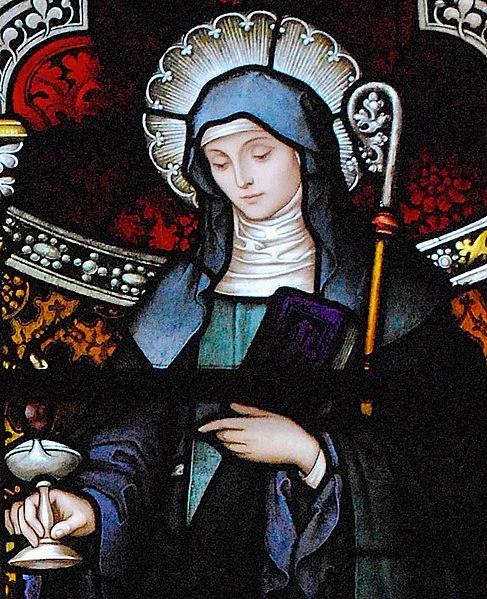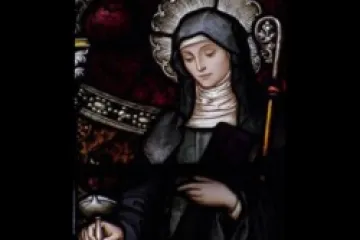Rome Newsroom, Feb 1, 2024 / 06:00 am
Ireland on Thursday is celebrating the 1,500th anniversary of the death of St. Brigid of Kildare, the Emerald Isle’s female patron saint.
St. Brigid (c. 453–524 A.D.) is credited with pioneering female monastic life in Ireland. Her feast is celebrated on Feb. 1, which became an annual public bank holiday across Ireland last year in her honor.
“St. Brigid was a huge figure of authority in the early Church, baptized by St. Patrick, professed by St. Mel, spiritual adviser to St. Conleth,” Bishop Denis Nulty of Kildare and Leighlin said at a Mass ahead of her feast.
Ireland’s Kildare County has organized lectures, pilgrimages, and many activities in its Brigid 1500 Program to mark the anniversary, including a workshop on how to weave a St. Brigid’s Cross — St. Brigid’s most enduring symbol.
A St. Brigid’s cross is traditionally made out of rushes or reeds freshly pulled from the ground.
Father Patrick Joseph Hughes, a country priest in County Cavan, can make a St. Brigid’s cross from rushes in a matter of minutes.
Hughes told CNA that the story that has been handed down over the years is that St. Brigid was trying to explain to the local chieftain, who did not believe in God, that Jesus was his savior and died on a cross for him. The chieftain did not understand, so she made a cross out of rushes from the ground and presented it to him: “‘Look,’ she said, ‘that’s a cross, and Jesus was stretched out on that for the world.’”
On the eve of the Feast of Saint Brigid, it is tradition in Ireland to make a St. Brigid’s Cross out of rushes.
— Courtney Mares (@catholicourtney) January 31, 2024
Last year while we were filming in Ireland, Father Patrick Hughes gave us a quick demonstration of how to make one.
Happy 1500th anniversary, St. Brigid! ☘️ pic.twitter.com/uSyEs82yAa
St. Brigid’s Catholic Church in Kildare will kick off the feast day on Feb. 1 with a Mass at 9:15 a.m. offered by Bishop Nulty.
The bishop recently installed St. Brigid’s relics in St. Brigid’s Catholic Church on Jan. 29 as part of the 1,500th anniversary celebrations.
The relics were taken from the bone fragment of St. Brigid’s head, which has been kept in St. John the Baptist Church in Lumiar, Portugal, since three Irish knights brought it there in 1273. The Portuguese church gave the relic to the Brigidine Sisters in Tullow, Ireland, in the 1930s, and they recently gifted it to St. Brigid’s in Kildare.
“Today we have brought her home,” Nulty said. “Obtaining the relic of a saint like Brigid is no easy feat. I visited Lumiar in October 2021 with the singular intention of securing a relic for St. Brigid’s Church. I was privileged then to hold the relic of her head, which is contained in a splendid brass casket. Sadly, I couldn’t squeeze it into my Ryan Air flight bag!”
Notably, the Catholic bishop and female Anglican leaders will also come together for an ecumenical service at 11 a.m. on the feast day at the historic St. Brigid’s Cathedral, built on the site of the ancient hilltop where St. Brigid founded her monastery in the year 480 A.D. The previously Catholic cathedral, consecrated in 1230, is now an Anglican cathedral.
Anglican Rev. Canon Alison Joyce from London will deliver the sermon at the ecumenical service.
The service will be followed by a “pause for peace,” a minute of silent prayer for peace. St. Brigid was known as a peacemaker. Among the many stories told about St. Brigid, local tradition holds that Brigid gave away her father’s sword in exchange for food for a family suffering from hunger.
The fifth-century abbess St. Brigid is one of Ireland’s three patron saints, along with St. Patrick and St. Columba. Most historians place her birth around the year 450, near the end of St. Patrick’s evangelistic mission.
(Story continues below)

It is notoriously hard to establish the historical details of Brigid’s life, but according to one of the more credible biographies of Brigid — Hugh de Blacam’s essay in “The Saints of Ireland” — Brigid was born out of wedlock to a pagan chieftain named Dubthach and a Christian slave woman named Broicsech. The chieftain sold the child’s pregnant mother to a new master but contracted for Brigid to be returned to him eventually.
Brigid was likely baptized as an infant and raised as a Catholic by her mother. Thus, she was well formed in the faith before leaving Broicsech’s slave quarters at around age 10 to live with Dubthach and his wife.
After this, Brigid’s faith grew immensely. She gave generously to the poor and tended to the sick. One story says Brigid once gave away her mother’s entire store of butter, which was later replenished after Brigid prayed.
Once she was released from servitude, she was expected to marry. However, Brigid had no interest in marrying. She went so far as to disfigure her own face and prayed that her beauty be taken from her so no one would want to marry her. Because she refused to change her mind about marriage, she received permission to enter religious life.
Brigid, along with seven friends, is credited with organizing communal consecrated religious life for women in Ireland.
In 480, Brigid founded her monastery in Kildare, which was called “Church of the Oak.” The monastery sat on top of a shrine to a Celtic goddess. Throughout the rest of her life, she established several monasteries across Ireland.
Brigid rooted her life as a nun in prayer, but she also performed substantial manual labor: cloth making, dairy farming, and raising sheep. She also spent time traveling across Ireland founding new houses and building up a uniquely Irish form of monasticism. When she was not traveling, pilgrims made their way to Kildare, seeking the advice of the abbess.
“What were the character traits that defined St. Brigid of Kildare? To mention just a few, she was hospitable, she was a peacemaker, she was a strong woman of faith,” Nulty said.






